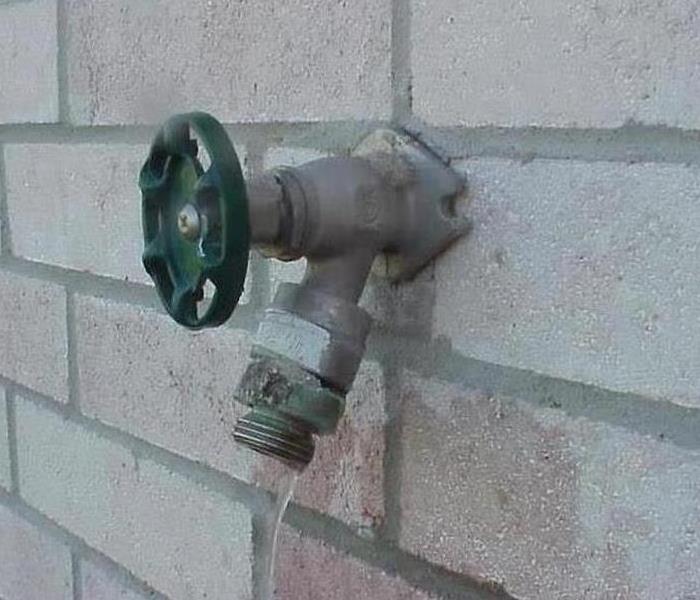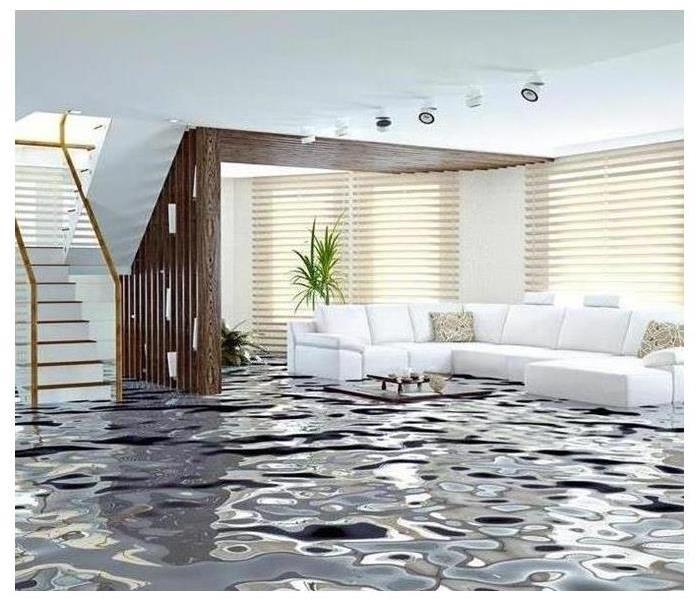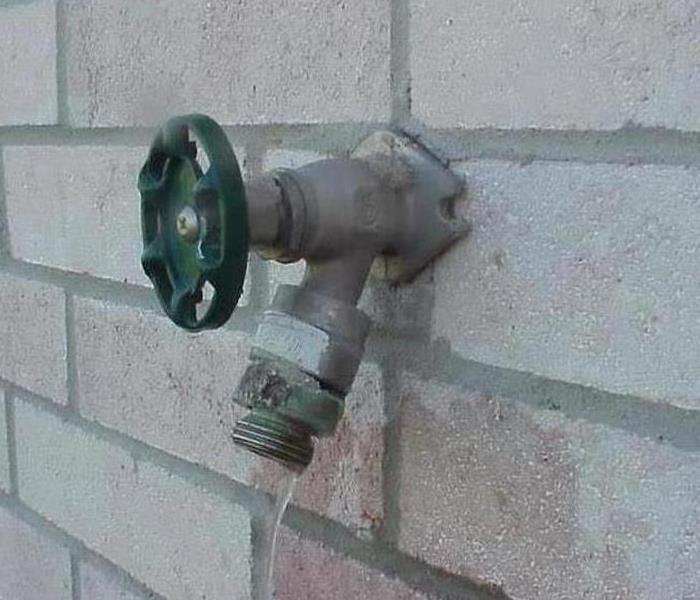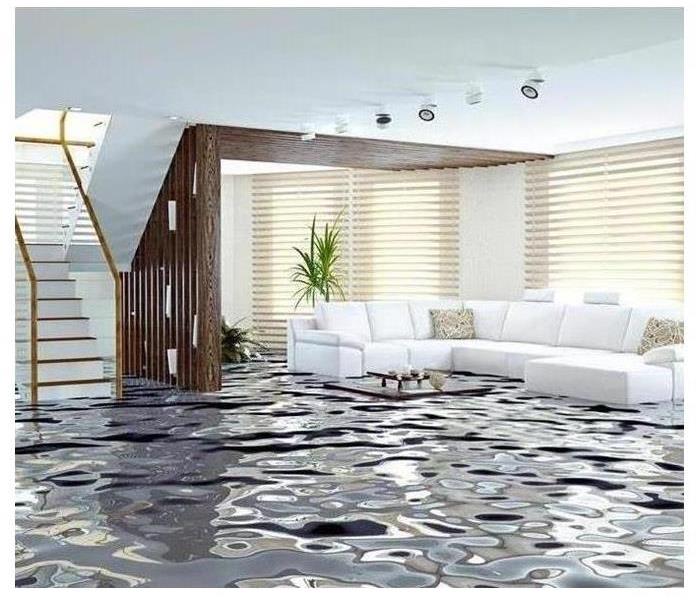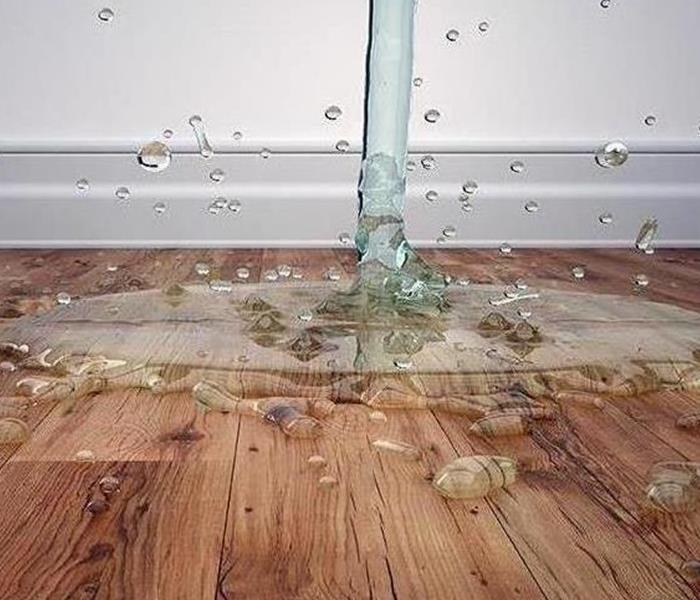Archived Water Damage Blog Posts
Emergency Water and fire Clean up
6/12/2024 (Permalink)
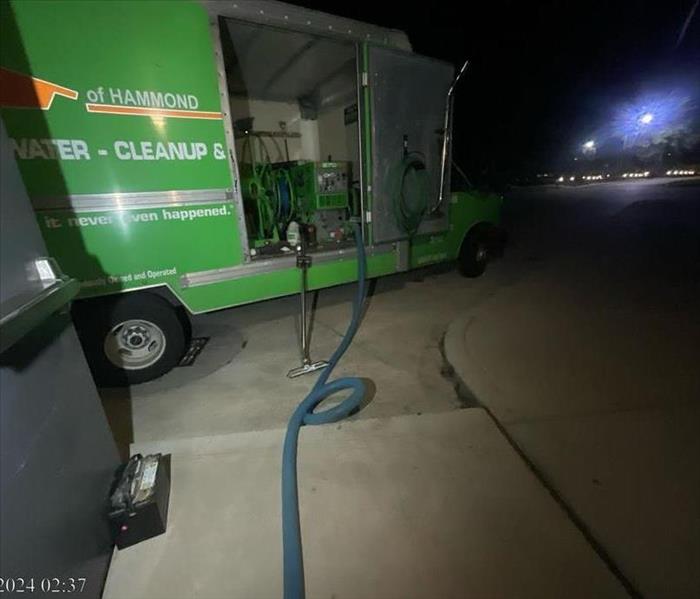 Night time, SERVPRO truck extracting water from a resent water job
Night time, SERVPRO truck extracting water from a resent water job
Emergency Water and fire Clean up
Water damage can strike at any time to your home or business. Our SERVPRO® team is always ready 24/7 for your call with water extraction services as we understand time is of the essence.
Recently, SERVPRO was called to assist a local school with water extraction from a leak cause by a small kitchen fire, Our emergency professionals were ready to respond and take immediate action, extracting and assessing the fire and water damage to the business.
Our team helped navigate the insurance claim process and coordinated the necessary paperwork for a quicker and easier experience. Immediate Fire and water cleanup services can indeed allow a business to reopen sooner than expected.
Here are some Key Benefits and steps to consider:
BENEFITS.
1. Minimizes Damage:
Rapid response helps contain and minimized further damage, reducing repair cost and downtime.
2. Prevents Mold Growth:
Quick water cleanup prevents mold which can take root within 24-48 hours, leading to health hazards and further complications.
3. Restores Operations:
Speedy clean up allows businesses to resume operations quickly, minimizing revenue loss and disruption.
4. Improves Safety:
Ensures a safe environment for employees and customers, avoiding potential liability issues.
Steps to Effective Immediate Cleanup:
1. Assessment and Planning:
Conduct a thorough assessment to understand the extent of damage and create a detailed cleanup plan.
2. Water Removal:
use pumps, vacuums, water extraction tools to remove standing water. Dehumidifiers and high efficient air mover to help dry the area quickly following IICRC protocol.
3. Debris Removal:
Remove damage materials and debris. Dispose of unsalvageable items properly. (Informed customer/insurance carrier when disposing of contents)
4. Cleaning and Sanitizing:
Clean and disinfect all affected areas to prevent health hazards and removed odors.
5. Restoration and Repairs:
Begin repairs to restore the property to its pre-damage condition.
Professional Help:
Hiring a professional company can expedite the process. SERVPRO of Hammond has the equipment, IICRC train technicians and the resources to handle cleanup and restoration efficiently and effectively.
Taking these steps ensures that the Business can reopen safely and swiftly minimizing downtime and long term impact.
SERVPRO of Hammond always Ready to Make it "Like it never even happened"
(985) 542-7388
24/7 Emergency Services
Sources of Outside Water Damage
4/16/2021 (Permalink)
There are many ways that water can infiltrate your home, often when you least expect it. It will destroy everything in its path and take over your entire world. In addition to increased stress levels, unexpected water damage can cause displacement for you and your family. Only a certified and insured restoration company should be trusted to mitigate the damage to your home. SERVPRO of Hammond is your local resource to get your home back in working order.
Water damage can occur from both interior and exterior sources. Below are some ways you can help prevent water damage inside your home that comes from outside sources.
Roof
- Ensure that shingles, flashings or tiles on your roof aren’t missing, broken, cracked, curled or damaged in other ways.
- Cut tree limbs that hang above your roof so they don’t cling to shingles and trap moisture.
- Make sure the vents, flues, chimneys, air conditioners, and evaporative coolers are properly installed and in good shape.
- Check for leaks around rooftop air-conditioning units, vents for exhaust or plumbing, or other specialized equipment.
Gutters and Downspouts
- Clear gutters and downspouts from leaves, twigs, and other debris. Also, check that they are in good condition so that water can flow freely. You can do this by installing metal screens to help prevent clogging.
- Ensure downspouts direct water at least five feet away from your home’s foundation. This helps direct water away from the foundation. Downspout extensions can be added if needed.
Doors and Windows
- Install window well covers to help prevent water and debris from getting trapped and causing water to eventually seep into your basement.
- Check for leaks near the corners of your doors and windows. Signs of leaks include peeling paint, paint discoloration or swollen frames.
- Installing overhangs or awnings above exterior doors and windows protects them from the sun, rain, and snow.
- Check for a tight fit on closed doors and windows. Any cracks between the sash and frame Close your doors and windows to check for a tight fit. Repair or replace damaged flashing or weather-stripping.
Walls
- Check for and repair cracked or broken siding boards, bricks, stone or another masonry, and structural sheathing.
- Remove any shrubs and other landscaping features from along the walls, and avoid directing water towards the house when irrigating the garden and plants to prevent excessive water near the foundation.
- Seal any openings from wiring, plumbing, phone, cable, and heating and air conditioning lines with foam or caulk. Repair any damaged or unpainted wood surrounding these openings.
- Termites can eat wood, plaster, and even metal siding causing holes and compromising structural integrity. Check for signs of termite activity on the walls and the wooden structures around your foundation.
- Ensure that the exhaust vent doors properly open and close.
Following these steps can help protect your home from exterior water damage. If water does happen to sneak into your home, make sure to have SERVPRO of Hammond on speed dial 985-542-7388. We’ll be there to make it “Like it never even happened.”
Contaminated Water Categories and Cleanup
4/15/2021 (Permalink)
As a homeowner in Tangipahoa, it’s possible you may have to deal with water damage from a leak or flood at some point in time. Several types of contaminated water require extra safety precautions, so it’s essential first to assess the kind of damage to determine how to proceed with removal and repair. Common types of contaminants may include the following:
- Cleaning agents such as soap or bleach
- Grease and oils
- Food residue
- Bodily waste
There are also several other unsafe chemicals and foreign objects that have led experts to create a system to categorize types of water.
Category 1: Clean Water
This type of water is most likely the result of a faucet overflow, broken water supply line, or household appliance malfunction. Keep in mind that although it may not be contaminated water, environmental conditions or the amount of time lapsed can cause the water to elevate to Category 2 or 3. Contact a water damage repair service within the first 48 hours of a clean water spill to prevent worsening damage.
Category 2: Grey Water
Possible sources of grey water can be from appliance discharge, broken sump pumps, and toilet water mixed with urination. Due to the rapid growth of bacteria and mold, cleanup should begin as soon as possible to prevent elevating grey water to Category 3.
Category 3: Black Water
This type of contaminated water is primarily composed of sewage backup containing human and animal waste. It may also source from rivers, streams, and oceans, which are often known to contain bacteria, fungi, and unsanitary chemicals. Contact a cleanup service immediately when this type of water is discovered.
Common Mistakes You're Making with Water Damage
4/14/2021 (Permalink)
When finding themselves amid a water damage event, many people immediately react by jumping in and cleaning up the mess. Beginning the restoration process as soon as possible is essential, but starting before you have taken the necessary steps or know what you are doing could make things worse in the end. A few of the most common mistakes in water damage clean up are listed below to help avoid these mishaps. The most critical mistake not to make is to hire a professional restoration company to do the dirty work for you. SERVPRO of Hammond is your local expert to help you navigate the “waters.”
Mistake #1 - Not Having the Job Done RIGHT the First Time
Adopting the “do it yourself” approach to water damage clean-up is often the go-to mindset. However, this is usually a more complex process than people think. It can be a long process, and following the proper procedures is very important. For example, if you neglect to begin airing out your home by opening up windows and doors for ventilation and using fans to dry things out as soon as possible, the damage will eventually be worse.
Mistake #2 - Not Being Completely Thorough
As mentioned above, the water damage restoration process done right requires that you be very thorough. Cutting corners and major shortcuts will not make a big difference and can cause more damage. It is better to have the job done right upfront, but it will not happen overnight. To ensure all the water is removed and mold will not begin to grow on, and in your walls, ceilings, and carpet, you will want to make sure your contractor is certified to do the work needed in an appropriate time frame.
Mistake #3 - Waiting Too Long
It can be tempting to put off dealing with flooding or water damage when it’s just a minor incident, especially when life is hectic. Even minor flooding can lead to significant damage in the long run. The water seeps into walls and flooring over time when not dried properly and can cause structural damage and mold growth. It’s not worth the risk of procrastinating. It could save you a lot of time, heartache, and money in the long run.
Mistake #4 - Not Involving a Certified Restoration Company
Trying to tackle the water damage restoration process on your own is a significant undertaking. Having it done right the first time requires the proper expertise, the right equipment, and enough time to be as thorough as required. Though it may seem like you have the time and resources to clean it up, you will soon realize the process is more involved than initially thought. Should you ever find yourself in a situation where your home or business has been compromised by flooding or water damage, don’t hesitate to contact the professionals at SERVPRO of Hammond.
Sources of Outside Water Damage
4/14/2021 (Permalink)
There are many ways that water can infiltrate your home, often when you least expect it. It will destroy everything in its path and take over your entire world. In addition to increased stress levels, unexpected water damage can cause displacement for you and your family. Only a certified and insured restoration company should be trusted to mitigate the damage to your home. SERVPRO of Hammond is your local resource to get your home back in working order.
Water damage can occur from both interior and exterior sources. Below are some ways you can help prevent water damage inside your home that comes from outside sources.
Roof
- Ensure that shingles, flashings or tiles on your roof aren’t missing, broken, cracked, curled or damaged in other ways.
- Cut tree limbs that hang above your roof so they don’t cling to shingles and trap moisture.
- Make sure the vents, flues, chimneys, air conditioners, and evaporative coolers are properly installed and in good shape.
- Check for leaks around rooftop air-conditioning units, vents for exhaust or plumbing, or other specialized equipment.
Gutters and Downspouts
- Clear gutters and downspouts from leaves, twigs, and other debris. Also, check that they are in good condition so that water can flow freely. You can do this by installing metal screens to help prevent clogging.
- Ensure downspouts direct water at least five feet away from your home’s foundation. This helps direct water away from the foundation. Downspout extensions can be added if needed.
Doors and Windows
- Install window well covers to help prevent water and debris from getting trapped and causing water to eventually seep into your basement.
- Check for leaks near the corners of your doors and windows. Signs of leaks include peeling paint, paint discoloration or swollen frames.
- Installing overhangs or awnings above exterior doors and windows protects them from the sun, rain, and snow.
- Check for a tight fit on closed doors and windows. Any cracks between the sash and frame Close your doors and windows to check for a tight fit. Repair or replace damaged flashing or weather-stripping.
Walls
- Check for and repair cracked or broken siding boards, bricks, stone or another masonry, and structural sheathing.
- Remove any shrubs and other landscaping features from along the walls, and avoid directing water towards the house when irrigating the garden and plants to prevent excessive water near the foundation.
- Seal any openings from wiring, plumbing, phone, cable, and heating and air conditioning lines with foam or caulk. Repair any damaged or unpainted wood surrounding these openings.
- Termites can eat wood, plaster, and even metal siding causing holes and compromising structural integrity. Check for signs of termite activity on the walls and the wooden structures around your foundation.
- Ensure that the exhaust vent doors properly open and close.
Following these steps can help protect your home from exterior water damage. If water does happen to sneak into your home, make sure to have SERVPRO of Hammond on speed dial 985-542-7388. We’ll be there to make it “Like it never even happened.”
Common Mistakes You're Making with Water Damage
4/12/2021 (Permalink)
When finding themselves amid a water damage event, many people immediately react by jumping in and cleaning up the mess. Beginning the restoration process as soon as possible is essential, but starting before you have taken the necessary steps or know what you are doing could make things worse in the end. A few of the most common mistakes in water damage clean up are listed below to help avoid these mishaps. The most critical mistake not to make is to hire a professional restoration company to do the dirty work for you. SERVPRO of Hammond is your local expert to help you navigate the “waters.”
Mistake #1 - Not Having the Job Done RIGHT the First Time
Adopting the “do it yourself” approach to water damage clean-up is often the go-to mindset. However, this is usually a more complex process than people think. It can be a long process, and following the proper procedures is very important. For example, if you neglect to begin airing out your home by opening up windows and doors for ventilation and using fans to dry things out as soon as possible, the damage will eventually be worse.
Mistake #2 - Not Being Completely Thorough
As mentioned above, the water damage restoration process done right requires that you be very thorough. Cutting corners and major shortcuts will not make a big difference and can cause more damage. It is better to have the job done right upfront, but it will not happen overnight. To ensure all the water is removed and mold will not begin to grow on, and in your walls, ceilings, and carpet, you will want to make sure your contractor is certified to do the work needed in an appropriate time frame.
Mistake #3 - Waiting Too Long
It can be tempting to put off dealing with flooding or water damage when it’s just a minor incident, especially when life is hectic. Even minor flooding can lead to significant damage in the long run. The water seeps into walls and flooring over time when not dried properly and can cause structural damage and mold growth. It’s not worth the risk of procrastinating. It could save you a lot of time, heartache, and money in the long run.
Mistake #4 - Not Involving a Certified Restoration Company
Trying to tackle the water damage restoration process on your own is a significant undertaking. Having it done right the first time requires the proper expertise, the right equipment, and enough time to be as thorough as required. Though it may seem like you have the time and resources to clean it up, you will soon realize the process is more involved than initially thought. Should you ever find yourself in a situation where your home or business has been compromised by flooding or water damage, don’t hesitate to contact the professionals at SERVPRO of Hammond.
24 Hour Emergency Water Damage Services
4/9/2021 (Permalink)
SERVPRO of Hammond is available 24 hours a day for water emergencies, large or small. When you are dealing with water damage, immediate action is crucial. A delay of just a few hours can greatly increase the severity of the water damage.
We Answer the Phone Ready to Help
Call Today - (985)-542-7388
We understand that when you call us, you may be feeling confused, stressed, and vulnerable. You need an expert to guide you through this crisis. SERVPRO of Hammond has the specific water damage training and experience to help you through this tough time. We specialize in water damage restoration—in fact, it's the cornerstone of our business.
What to Expect
When you call, we will ask several questions regarding your water damage emergency. These questions will help us determine what equipment and resources to bring, including how many trained SERVPRO Professionals may be needed.
Our SERVPRO Representative will ask several questions:
- Your name and contact information
- Your insurance information (if applicable)
- The street address of the water-damaged home or business
- When did the flooding or water damage occur?
- What caused the water damage (if known)?
- Is there electricity available (on-site)?
About SERVPRO of Hammond
SERVPRO of Hammond specializes in the cleanup and restoration of residential and commercial property after a fire, smoke or water damage event. Our staff is highly trained in property damage restoration. From initial and ongoing training at SERVPRO’s corporate training facility to regular IICRC-industry certification, rest assured our staff is equipped with the knowledge to restore your property.
SERVPRO of Hammond Water Damage Process Overview
4/9/2021 (Permalink)
Here at SERVPRO of Hammond, we strive to provide excellent communication and prompt service to our customers. When we receive notification of damage to a customer's home, we understand that they are most distressed and unsure of the mitigation process that is about to unfold. Below is a bird's eye view of the process that we follow for water damages.
One Hour:
Within one hour from notice of loss, SERVPRO of Hammond will contact you to arrange for service. During this call, our trained office staff will ask important questions regarding your damage, insurance information, and any additional contact information that is needed.
Four Hours:
Within four hours of loss notification, SERVPRO of Hammond's trained technicians will be on-site to start mitigation services. The key to reducing damage and saving money is responding quickly to your damage.
Detailed Explanation:
A trained, uniformed, and equipped SERVPRO of Hammond professional will walk you through the job process step-by-step, explaining what to expect and the anticipated outcome. All damages are different, and our on-site personnel will ensure that you know each aspect of your damage.
Pretesting:
A SERVPRO of Hammond professional will begin pretesting for remediation, working from the source of the damage outward. Water travels through different materials at different speeds. What might look like minor damage could have moved to another portion of the home via the wet materials.
Eight Hours:
Within eight business hours of on-site arrival, a verbal briefing of the scope will be communicated to the appropriate individual, most times your insurance adjuster or property manager.
Cleaning & Restoration:
SERVPRO of Sumner County will work neatly and efficiently to help you regain control of your property when a damaging event has occurred. Our certified teams will use state-of-the-art restoration techniques to ensure that your property is taken care of right the first time.
Final Walk-Through:
After the work has been completed, a final walk-through will be conducted with you to help ensure your satisfaction.
If you need water damage services, call our SERVPRO of Hammond office at 985-542-7388.
Category 3 Water Damage
5/5/2020 (Permalink)
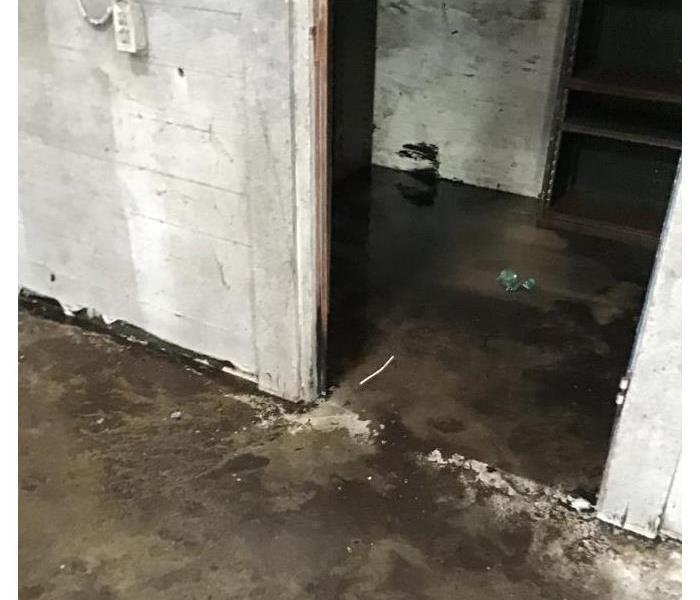 Water loss by flood
Water loss by flood
In the restoration industry there are three categories of water and as industry professionals, it is our job to determine which category of water each damage has. The most severe category is Category 3 which is also commonly called CAT 3, Black Water or Dirty Water. Category 3 water (Black Water) is highly contaminated water that is potentially toxic to anyone inside the dwelling.
The water is considered category 3 (Black Water) if it meets any of the following criteria. Sources include sewage backup, flooding from rivers or streams, toilet overflow with feces or stagnant liquid that has begun to support bacterial growth. If Category 1 or Category 2 has been left untreated for more than three days, it is likely that it will develop into Category 3 (Black Water). If your damage is deemed as Category 3 (Black Water), it is likely that many pieces of your property will need to be replaced. Anything porous, such as furniture, carpeting and drywall is grossly contaminated. Category 3 water, although referred to as Black Water or Dirty Water is not always visually black or dirty. In fact, most times it is completely translucent.
If you are ever faced with damage to your home act fast, find your source and call the professionals at SERVPRO of Hammond 985-542-7388. We will assess the damage and ensure that it is properly mitigated to ensure your safety.
Contaminated Water Categories and Cleanup
4/14/2020 (Permalink)
As a homeowner in Tangipahoa, it’s possible you may have to deal with water damage from a leak or flood at some point in time. Several types of contaminated water require extra safety precautions, so it’s essential first to assess the kind of damage to determine how to proceed with removal and repair. Common types of contaminants may include the following:
- Cleaning agents such as soap or bleach
- Grease and oils
- Food residue
- Bodily waste
There are also several other unsafe chemicals and foreign objects that have led experts to create a system to categorize types of water.
Category 1: Clean Water
This type of water is most likely the result of a faucet overflow, broken water supply line, or household appliance malfunction. Keep in mind that although it may not be contaminated water, environmental conditions or the amount of time lapsed can cause the water to elevate to Category 2 or 3. Contact a water damage repair service within the first 48 hours of a clean water spill to prevent worsening damage.
Category 2: Grey Water
Possible sources of grey water can be from appliance discharge, broken sump pumps, and toilet water mixed with urination. Due to the rapid growth of bacteria and mold, cleanup should begin as soon as possible to prevent elevating grey water to Category 3.
Category 3: Black Water
This type of contaminated water is primarily composed of sewage backup containing human and animal waste. It may also source from rivers, streams, and oceans, which are often known to contain bacteria, fungi, and unsanitary chemicals. Contact a cleanup service immediately when this type of water is discovered.






 24/7 Emergency Service
24/7 Emergency Service
